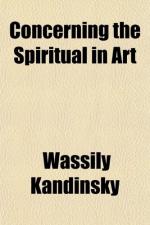The harmony of the new art demands a more subtle construction than this, something that appeals less to the eye and more to the soul. This “concealed construction” may arise from an apparently fortuitous selection of forms on the canvas. Their external lack of cohesion is their internal harmony. This haphazard arrangement of forms may be the future of artistic harmony. Their fundamental relationship will finally be able to be expressed in mathematical form, but in terms irregular rather than regular.
VIII. ART AND ARTISTS
The work of art is born of the artist in a mysterious and secret way. From him it gains life and being. Nor is its existence casual and inconsequent, but it has a definite and purposeful strength, alike in its material and spiritual life. It exists and has power to create spiritual atmosphere; and from this inner standpoint one judges whether it is a good work of art or a bad one. If its “form” is bad it means that the form is too feeble in meaning to call forth corresponding vibrations of the soul.
[Footnote: So-called indecent pictures are either incapable of causing vibrations of the soul (in which case they are not art) or they are so capable. In the latter case they are not to be spurned absolutely, even though at the same time they gratify what nowadays we are pleased to call the “lower bodily tastes.”] Therefore a picture is not necessarily “well painted” if it possesses the “values” of which the French so constantly speak. It is only well painted if its spiritual value is complete and satisfying. “Good drawing” is drawing that cannot be altered without destruction of this inner value, quite irrespective of its correctness as anatomy, botany, or any other science. There is no question of a violation of natural form, but only of the need of the artist for such form. Similarly colours are used not because they are true to nature, but because they are necessary to the particular picture. In fact, the artist is not only justified in using, but it is his duty to use only those forms which fulfil his own need. Absolute freedom, whether from anatomy or anything of the kind, must be given the artist in his choice of material. Such spiritual freedom is as necessary in art as it is in life. [Footnote: This freedom is man’s weapon against the Philistines. It is based on the inner need.]
Note, however, that blind following of scientific precept is less blameworthy than its blind and purposeless rejection. The former produces at least an imitation of material objects which may be of some use.
[Footnote: Plainly, an imitation of nature, if made by the hand of an artist, is not a pure reproduction. The voice of the soul will in some degree at least make itself heard. As contrasts one may quote a landscape of Canaletto and those sadly famous heads by Denner.—(Alte Pinakothek, Munich.)]
The latter is an artistic betrayal and brings confusion in its train. The former leaves the spiritual atmosphere empty; the latter poisons it.




